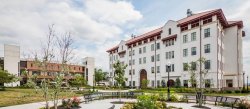CELS Receives First LEED Gold Certification on Campus
Leadership in Energy and Environmental Design awards the Center for Environmental & Life Sciences building Gold status.
Posted in: PSEG ISS

The Center for Environmental and Life Sciences is the first building on our campus to receive a Gold status from the Leadership in Energy and Environmental Design (LEED). After all the planning and work dedicated to the CELS project this wonderful accomplishment, for the University and the College of Science and Mathematics, adds to the already great reputation of one of the newest buildings on our campus. The CELS building received 61 points, with 60 and above awarded Gold status.
About LEED Certification
Projects pursuing LEED certification earn points across several areas that address sustainability issues. Based on the number of points achieved, a project then receives one of four LEED rating levels: Certified, Silver, Gold and Platinum. LEED-certified buildings are resource efficient.
Point Breakdown
Below is the detailed points breakdown for LEED certification:
Sustainable Sites
- SSp1 Construction Activity Pollution Prevention Y
- SSc1 Site Selection 1/1
- SSc2 Development Density and Community Connectivity 5/5
- SSc3 Brownfield Redevelopment 0/1
- SSc4.1Alternative Transportation-Public Transportation Access 6/6
- SSc4.2Alternative Transportation-Bicycle Storage and Changing Room 0/1
- SSc4.3Alternative Transportation-Low-Emitting and Fuel-Efficient V 3/3
- SSc4.4Alternative Transportation-Parking Capacity 2/2
- SSc5.1Site Development-Protect or Restore Habitat 0/1
- SSc5.2Site Development-Maximize Open Space 1/1
- SSc6.1Stormwater Design-Quantity Control 0/1
- SSc6.2Stormwater Design-Quality Control 0/1
- SSc7.1Heat Island Effect, Non-Roof 0/1
- SSc7.2Heat Island Effect-Roof 0/1
- SSc8 Light Pollution Reduction 0/1
Water Efficiency
- WEp1 Water Use Reduction, 20% Reduction Y
- WEc1 Water Efficient Landscaping 4/4
- WEc2 Innovative Wastewater Technologies 0/2
- WEc3 Water Use Reduction 4/4
Energy and Atmosphere
- EAp1 Fundamental Commissioning of the Building Energy Systems Y
- EAp2 Minimum Energy Performance Y
- EAp3 Fundamental Refrigerant Mgmt Y
- EAc1 Optimize Energy Performance 3/19
- EAc2 On-Site Renewable Energy 0/7
- EAc3 Enhanced Commissioning 2/2
- EAc4 Enhanced Refrigerant Mgmt 2/2
- EAc5 Measurement and Verification 1/3
- EAc6 Green Power 2/2
Materials and Resources
- MRp1 Storage and Collection of Recyclables Y
- MRc1.1Building Reuse-Maintain Existing Walls, Floors and Roof 0/3
- MRc1.2Building Reuse – Maintain 50% of Interior Non-Structural Ele 0/1
- MRc2 Construction Waste Mgmt 2/2
- MRc3 Materials Reuse 0/2
- MRc4 Recycled Content 2/2
- MRc5 Regional Materials 2/2
- MRc6 Rapidly Renewable Materials 0/1
- MRc7 Certified Wood 1/1
Indoor Environmental Quality
- IEQp1 Minimum IAQ Performance Y
- IEQp2 Environmental Tobacco Smoke (ETS) Control Y
- IEQc1 Outdoor Air Delivery Monitoring 1/1
- IEQc2 Increased Ventilation 1/1
- IEQc3.1Construction IAQ Mgmt Plan-During Construction 1/1
- IEQc3.2Construction IAQ Mgmt Plan-Before Occupancy 1/1
- IEQc4.1Low-Emitting Materials-Adhesives and Sealants 1/1
- IEQc4.2Low-Emitting Materials-Paints and Coatings 1/1
- IEQc4.3Low-Emitting Materials-Flooring Systems 1/1
- IEQc4.4Low-Emitting Materials-Composite Wood and Agrifiber Products 1/1
- IEQc5 Indoor Chemical and Pollutant Source Control 1/1
- IEQc6.1Controllability of Systems-Lighting 1/1
- IEQc6.2Controllability of Systems-Thermal Comfort 0/1
- IEQc7.1Thermal Comfort-Design 1/1
- IEQc7.2Thermal Comfort-Verification 1/1
- IEQc8.1Daylight and Views-Daylight 0/1
- IEQc8.2Daylight and Views-Views 0/1
Innovation in Design
- IDc1.1 Building as a Teaching Tool 1/1
- IDc1.1 Innovation in Design 0/1
- IDc1.2 Innovation in Design 0/1
- IDc1.2 Green Power 1/1
- IDc1.3 Innovation in Design 0/1
- IDc1.3 Fume Hood Commissioning 1/1
- IDc1.4 Innovation in Design 0/1
- IDc1.4 Green Cleaning Policy 0/1
- IDc1.5 MR 4 Recycled Content 1/1
- IDc1.5 Innovation in Design 0/1
- IDc2 LEED® Accredited Professional 1/1
Regional Priority Credits
- SSc4.1Alternative Transportation-Public Transportation Access 1/1
TOTAL: 61 OF 107
